 W
WA polyptych is a painting which is divided into sections, or panels. Specifically, a "diptych" is a two-part work of art; a "triptych" is a three-part work; a tetraptych or quadriptych has four parts; pentaptych five; hexaptych six; heptaptych seven; octaptych eight parts; enneaptych nine; and decaptych has ten parts.
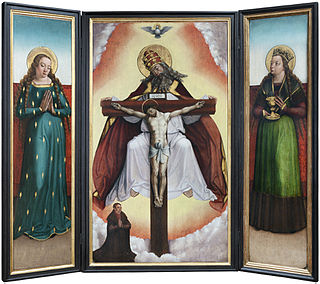 W
WThe Altarpiece of the Holy Trinity is a work by the Master of the Litoměřice Altarpiece dating from around 1520. It is on display in the permanent collection of the National Gallery in Prague.
 W
WThe Altarpiece of the Saints John is a painting by Bernat Martorell conserved at the National Art Museum of Catalonia.
 W
WThe Averoldi Polyptych, also known as the Averoldi Altarpiece, is a painting by the Italian Renaissance painter Titian, dating to 1520–1522, in the basilica church of Santi Nazaro e Celso in Brescia, northern Italy.
 W
WThe Badia Polyptych is a painting by the Italian artist Giotto, painted around 1300 and housed in the Uffizi Gallery of Florence.
 W
WThe Beaune Altarpiece is a large polyptych c. 1445–1450 altarpiece by the Early Netherlandish artist Rogier van der Weyden, painted in oil on oak panels with parts later transferred to canvas. It consists of fifteen paintings on nine panels, of which six are painted on both sides. Unusually for the period, it retains some of its original frames.
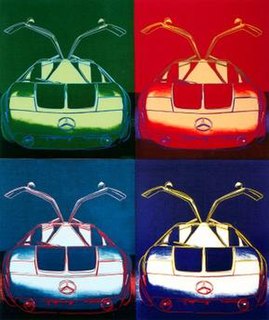 W
WCars is a series of artworks by the American artist Andy Warhol, commissioned by Mercedes-Benz in 1986.
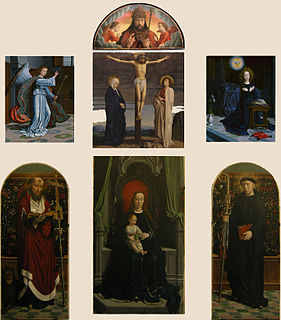 W
WThe Cervara Altarpiece or Cervara Polyptych was an oil-on-oak-panel altarpiece painted by the Flemish painter Gerard David early in the 16th century for the high altar of Cervara Abbey in Liguria, Italy.
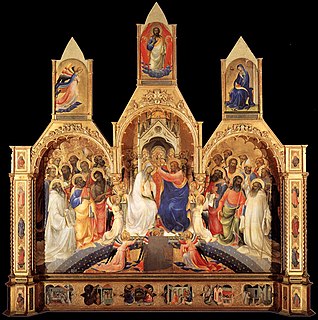 W
WThe Coronation of the Virgin is a tempera on panel polyptych by the Italian late Gothic artist Lorenzo Monaco, centred on the subject of the Coronation of the Virgin. Once in the Camaldolese monastery of Santa Maria degli Angeli, it is now housed in the Uffizi Gallery in Florence. It is dated February 1413 which, in the Florentine calendar, corresponded to 1414.
 W
WEarthly Vanity and Divine Salvation is a 1480s painting by the German-born citizen of Bruges, Hans Memling. It is on display in the Musée des Beaux-Arts of Strasbourg, France. Its inventory number is 185.
 W
WThe Ghent Altarpiece is a large and complex 15th-century polyptych altarpiece in St Bavo's Cathedral, Ghent, Belgium. It was begun c. the mid-1420s and completed by 1432, and is attributed to the Early Flemish painters and brothers Hubert and Jan van Eyck. The altarpiece is considered a masterpiece of European art and one of the world's treasures.
 W
WThe Isenheim Altarpiece is an altarpiece sculpted and painted by, respectively, the Germans Nikolaus of Haguenau and Matthias Grünewald in 1512–1516. It is on display at the Unterlinden Museum at Colmar, Alsace, in France. It is Grünewald's largest work, and is regarded as his masterpiece. It was painted for the Monastery of St. Anthony in Issenheim near Colmar, which specialized in hospital work. The Antonine monks of the monastery were noted for their care of plague sufferers as well as their treatment of skin diseases, such as ergotism. The image of the crucified Christ is pitted with plague-type sores, showing patients that Jesus understood and shared their afflictions. The veracity of the work's depictions of medical conditions was unusual in the history of European art.
 W
WThe Lazara Altarpiece is a 1449-1452 five-panel tempera on panel altarpiece by Francesco Squarcione, signed by the artist and now in the Musei Civici of Padua. It and his Madonna and Child are his only two definitively confirmed works.
 W
WThe Madonna and Child with Saints Polyptych is a five piece Madonna polyptych by Italian Renaissance artist Duccio di Buoninsegna, also referred to as Polyptych no. 47 by Duccio.
 W
WThe Maestà, or Maestà of Duccio is an altarpiece composed of many individual paintings commissioned by the city of Siena in 1308 from the artist Duccio di Buoninsegna and is his most famous work. The front panels make up a large enthroned Madonna and Child with saints and angels, and a predella of the Childhood of Christ with prophets. The reverse has the rest of a combined cycle of the Life of the Virgin and the Life of Christ in a total of forty-three small scenes; several panels are now dispersed or lost. The base of the panel has an inscription that reads : "Holy Mother of God, be thou the cause of peace for Siena and life to Duccio because he painted thee thus." Though it took a generation for its effect truly to be felt, Duccio's Maestà set Italian painting on a course leading away from the hieratic representations of Byzantine art towards more direct presentations of reality.
 W
WThe Polyptych of Perugia is a complex of paintings by the Italian Renaissance master Piero della Francesca, finished around 1470. It is housed in the Galleria Nazionale dell'Umbria, Perugia, Italy.
 W
WThe Polyptych of the Misericordia is a painting conserved in the Museo Civico di Sansepolcro in the town of Sansepolcro, region of Tuscany, Italy. The painting is one of the earliest works of the Italian Renaissance painter Piero della Francesca, who was born in the town. The central panel is of the common motif of the Virgin of Mercy or Madonna della Misericordia.
 W
WThe Saint Catherine of Alexandria Polyptych is a painting by the Italian medieval artist Simone Martini, dating to 1320. Originally placed at the high altar of the church of Santa Caterina in Pisa, it is now housed in the Museo Nazionale di San Matteo of the same city.
 W
WSan Gregorio Polyptych is a polyptych painting by the Italian Renaissance master Antonello da Messina, completed in 1473 and housed in the Regional Museum of Messina, southern Italy.
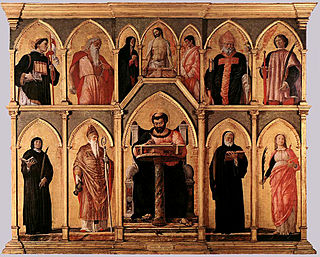 W
WThe San Lucas Altarpiece, also known as the San Lucas Polyptych, is a polyptych panel painting by Northern Italian Renaissance painter Andrea Mantegna. The altarpiece is a polyptych panel painting featuring 12 figures each in his or her own arch. The seven figures in the top row flank the central figure of Jesus Christ. The five beneath flank Saint Luke.
 W
WThe San Pietro Polyptych is a polyptych by Italian Renaissance master Perugino, painted around 1496–1500. The panels are now in different locations: the lunette and the central panel, depicting the Ascension of Christ, are in the Museum of Fine Arts of Lyon, France.
 W
WThe Stefaneschi Altarpiece is a triptych by the Italian painter Giotto, commissioned by Cardinal Giacomo Gaetani Stefaneschi to serve as an altarpiece for one of the altars of Old St. Peter's Basilica in Rome.
 W
WThe Tarlati polyptych is a Renaissance polyptych painted by the Italian artist Pietro Lorenzetti, with tempera and gold on panel, in 1320. It is located at the church of Santa Maria della Pieve in Arezzo, Italy.
 W
WThe Třeboň Altarpiece, also known as Wittingau altarpiece, is one of the most important works of European Gothic panel painting. Of the original large altarpiece retable created in about 1380 by an anonymous Gothic painter called the Master of the Třeboň Altarpiece, three wings, painted on both sides, have survived. The altarpiece is one of the works that helped towards the emergence of the International Gothic style and which influenced the development of art in a broad European context. It was originally created for the Augustinian Church of St Giles in Třeboň and is now part of the permanent collection of medieval art of the National Gallery in Prague.
 W
WA winged altarpiece or winged retable is a special form of altarpiece, common in Central Europe, in which the fixed shrine or corpus can be enclosed by two (triptych), four (pentaptych) or more (polyptych) movable wings. The technical terms are derived from Ancient Greek: τρίς: trís or "triple"; πέντε: pénte or "five"; πολύς: polýs or "many"; and πτυχή: ptychē or "fold, layer".
 W
WThe Winged Altarpiece of Our Lady from Seeberg is a Late Gothic altarpiece originally located in the Church of St Wolfgang in Seeberg. The sculptor, known as the Master of the Marian Altarpiece from Seeberg, received his training in the workshop of the Bavarian sculptor Hans Leinberger, and so the works of the two artists are similar in style and date from the same time. The workshop of the Master of the Marian Altarpiece from Seeberg was most probably located directly in Cheb, where it combined the local woodcarving tradition of the successful workshop of Hans Maler with the contemporary fashionable style of the Danube School. The altarpiece from Seeberg is one of the few outstanding works of Late Gothic sculpture to have been preserved in the Cheb region. It is displayed in the permanent exhibition of the Gallery of Fine Arts in Cheb.